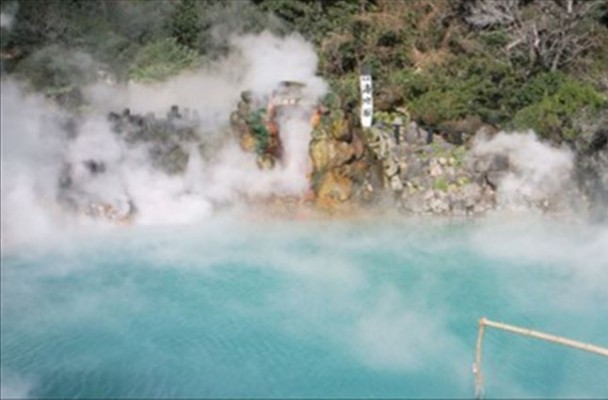Tell anyone that you’re headed for Kyushu island and they’ll tell you the same thing: Kyushu is onsen country. Onsen, or hot springs, are dotted across the island. Not just reserved for soaking and relaxing, onsen also have curative properties due to the variety of minerals dissolved in the water.
Perhaps the best-known city for its onsen is Beppu, located in Oita Prefecture. Though arguably its glory days of the 1980s are long past, the city still attracts tourists from all over Japan who want to stay at local ryokan, or inns, and enjoy the onsen.
However, there is something else which attracts tourists to Beppu. Unique to this city is a collection of onsen that are not for bathing, due to either their high temperatures or other unusual characteristics. They are known somewhat intimidatingly as the Eight Hells of Beppu.
Getting to Beppu
Visitors arriving in Kyushu via Oita or Fukuoka Airport can take a bus, which will arrive at either Kitahama bus stop or JR Beppu Station. Once in the city, there are plenty of options for reaching the Eight Hells.
Kannawa District Hells
Six of the Eight Hells are located in the Kannawa district of Beppu. They are accessible by taking buses 5, 7, or 9 from JR Beppu Station to Kannawa bus station. But because parking is free at each of the Hells, it is also convenient to tour all eight, and the rest of Beppu for that matter, by car.
Let's go to the Eight Hells of Beppu!
1. Sea Hell (Umi Jigoku)
Temperature: 98°C
The Sea Hell gets its name from its main attraction: a pool of boiling water which is turquoise blue like a tropical sea. There are also a couple of smaller, orange-colored pools as well as a hothouse.
2. Shaven Head Monk’s Hell (Oniishi Bozu Jigoku)
Temperature: 99°C
This Hell differs from the rest in that it is a boiling grey pool of mud. The bubbles which form are said to resemble the top of a Buddhist monk’s bald head, giving this hell its name.
3. White Hell (Shiraike Jigoku)
Temperature: 95°C
Due to the minerals in the pool, the water appears a pale shade of blueish-white. There is a tropical fish aquarium in the complex, heated by the onsen.
4. Cooking Pot Hell (Kamado Jigoku)
Temperature: 90°C
This Hell is composed of multiple pools, including a blue one with a sacred stone protruding from the middle. Visitors can order food, such as eggs, to be boiled in the waters of this hell.
5. Crocodile Hell (Oniyama Jigoku)
Temperature: 99°C
Visitors to this Hell will get to see close to a hundred crocodiles either soaking in or sunbathing beside one of the many fenced off pools in the complex.
6. Mountain Hell (Yama Jigoku)
Temperature: 90°CAnimals such as hippopotamuses are kept in the complex. However, as with the Crocodile Hell, some guests have questioned whether the animals are being treated humanely.
Shibaseki District Hells
The remaining two Hells are located in the Shibaseki district. Visitors can take bus 16/16A from Kannawa to Chinoikejigoku-mae, returning by bus 26/26A.
7. Blood Hell (Chinoike Jigoku)
Temperature: 78°C
Estimated to be one of the oldest onsen in Japan, dating back 1300 years, this Hell gets its name from its deep red color. The spring water feeding the pool is not that color but changes when it comes in contact with the metal-heavy earth deposits in the pool.
8. Tornado Hell (Tatsumaki Hell)
Temperature: 105°C
This Hell is basically a geyser which erupts every 30-40 minutes.
Spot Information
Each of the Hells is open from 8am until 5pm. A separate ticket to each one costs between 400 yen to 550 yen at time. So for visitors planning on seeing at least half of the Hells, it makes sense to get the collective entry ticket for 2100 yen.







Comments